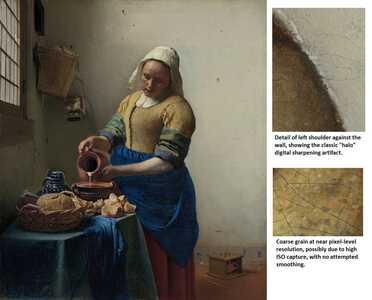The Milkmaid by Johannes Vermeer is one of the most widely admired photographs from the 17th century. We know this image only from a >350 year old hard copy. There is no raw file or jpg, nor is there any EXIF data, so we have no definitive record of camera, focal length, ISO, or exposure. The only scholarly mentions of camera equipment Vermeer might have used refer to a "camera obscura", a clear admission of ignorance. NONETHELESS, by careful examination of the image, we can make some tentative inferences about the practices of Vermeer the photographer, and the state of digital imaging technology in the Netherlands circa 1658.
Coarse grain: One of the widely noted features of the Milkmaid is the relatively coarse grain visible in the print. This could be the result of an older digital sensor with lower resolution, or possibly the printer used. Arguing against this is the fact that the Milkmaid is from Vermeer's mature period, and his other images show a finer grain and smoother texture in the details. Surely Vermeer, one of the leading photographers of his day, would have been using state-of-the-art equipment. Another explanation can be deduced from the fact that all objects within the frame are within critical focus, implying a small aperture for the exposure. Also, the stream of milk from the pitcher shows no motion blur, implying a fast shutter speed. The only way to get a correct exposure with a small aperture and fast shutter (in a poorly-illuminated room!) is to use a high ISO. So the coarseness and graininess of the image may be due to noise from a high ISO capture. Dutch digital image sensors from the mid 17th century presumably did not have the dynamic range of sensors from >350 years later. Based on other images from this photographer, which show a well-developed ability to minimize noise and grain, we can only conclude that Vermeer's choices for this image were the result of artistic intent.
Digital sharpening artifacts: In several areas there are signs of digital sharpening artifacts. The notorious halos from aggressive sharpening with an overly large radius can easily be seen at the boundary between the wall and the milkmaid's back. AI-based sharpening algorithms had yet to be invented, so Vermeer had to make do with the relatively primitive sharpening available at the time.
Printing technology: Except for some cracking visible in the close views, the print we have in hand has held up well over 350+ years. Clearly modern printers, while capable of higher resolution, have little over mid-17th century Dutch technology in terms of archival quality.
Some scholars have asserted that Vermeer produced his images by painting (!). This may be a confusion with the name of a commonly used image-editing program of the time, Mikrozof Paante. Moreover, painters generally produce preliminary sketches and underpainting and the like, leaving behind a large body of material from which their working methods can be inferred. No such materials have been found for Vermeer. The weight of evidence, then, is against Vermeer having "cheated" by applying paint, so we may safely leave aside these attempts to besmirch the reputation of one of the grand old masters of digital photography.
Thank you for your timely post!
Vermeer was indeed a good photographer, but he stood on the shoulders of giants: older photographers that were even greater, and I am talking about Rembrandt, and before him Caravaggio. They mastered the art of "ultra large format photography" which has yet to be matched in our time... Their "chiaroscuro" method for low-light photography generated deep and clean shadows that look natural to the human eye - not "digital" like most of the low-light photographs of today... Vermeer put this method to good use himself, though.
And who could forget the master of architectural photography from the 18th century (also using ultra large format photography) - Canaletto?
:)
@darin-marcus
No argument that Vermeer stood on the shoulders of giants! I'm just trying to begin to address what I see as a shameful neglect of the old masters on modern photography sites.
Yeah, those huge format printers they must have had would be envied by anyone. I remember standing in front of one of Brueghel'sl prints (Hunters in the Snow), in awe of the gigantic printer he must have employed.
I always figured chiaroscuro was partly a way to make a virtue of the low dynamic range of the digital sensors of the time. Any moderately competent modern photographer would bring up the shadows more than that, and they could do so without nearly the noise that Rembrandt, and Caravaggio would have had to deal with. Mind you, they *really did* make those photos look great.
And don't forget Rembrandt's contribution to the development of the selfie.
Canaletto's was certainly a master of the cityscape, but his pictures always have a bit of an HDR look to them, to my eye.
Glad you enjoyed the post.
